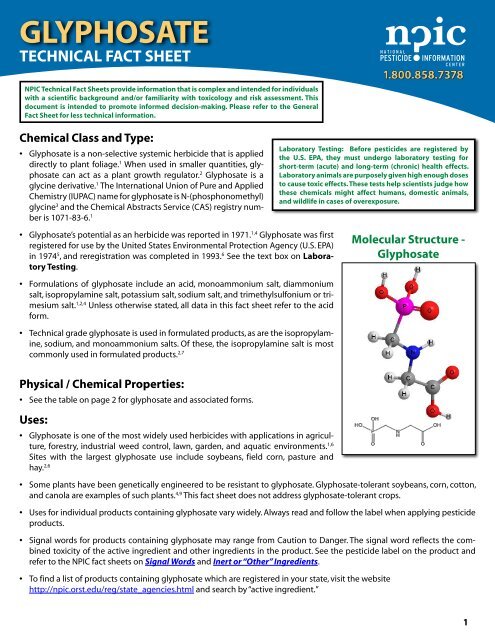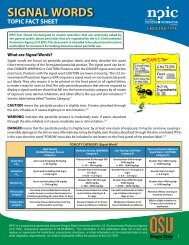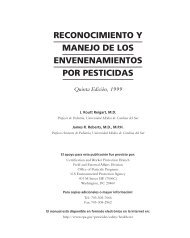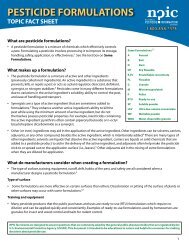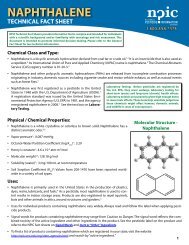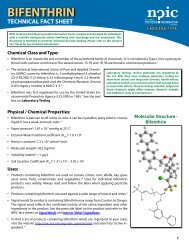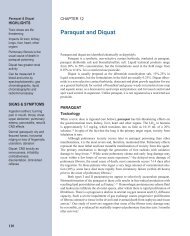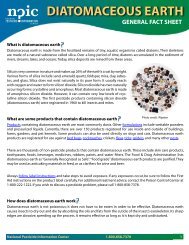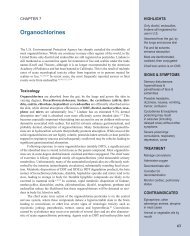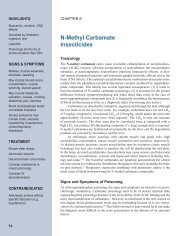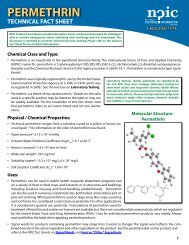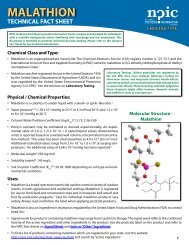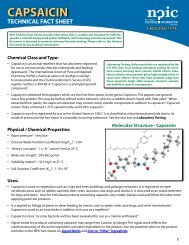Glyphosate Technical Fact Sheet - National Pesticide Information ...
Glyphosate Technical Fact Sheet - National Pesticide Information ...
Glyphosate Technical Fact Sheet - National Pesticide Information ...
Create successful ePaper yourself
Turn your PDF publications into a flip-book with our unique Google optimized e-Paper software.
GLYPHOSATE<br />
TECHNICAL FACT SHEET<br />
Chemical Class and Type:<br />
• <strong>Glyphosate</strong> is a non-selective systemic herbicide that is applied<br />
directly to plant foliage. 1 When used in smaller quantities, glyphosate<br />
can act as a plant growth regulator. 2 <strong>Glyphosate</strong> is a<br />
glycine derivative. 1 The International Union of Pure and Applied<br />
Chemistry (IUPAC) name for glyphosate is N-(phosphonomethyl)<br />
glycine3 and the Chemical Abstracts Service (CAS) registry number<br />
is 1071-83-6. 1<br />
1,4 • <strong>Glyphosate</strong>’s potential as an herbicide was reported in 1971. <strong>Glyphosate</strong> was first<br />
registered for use by the United States Environmental Protection Agency (U.S. EPA)<br />
in 19745 , and reregistration was completed in 1993. 6 See the text box on Laboratory<br />
Testing.<br />
• Formulations of glyphosate include an acid, monoammonium salt, diammonium<br />
salt, isopropylamine salt, potassium salt, sodium salt, and trimethylsulfonium or trimesium<br />
salt. 1,2,4 Unless otherwise stated, all data in this fact sheet refer to the acid<br />
form.<br />
• <strong>Technical</strong> grade glyphosate is used in formulated products, as are the isopropylamine,<br />
sodium, and monoammonium salts. Of these, the isopropylamine salt is most<br />
commonly used in formulated products. 2,7<br />
Physical / Chemical Properties:<br />
•<br />
See the table on page 2 for glyphosate and associated forms.<br />
Uses:<br />
• <strong>Glyphosate</strong> is one of the most widely used herbicides with applications in agriculture,<br />
forestry, industrial weed control, lawn, garden, and aquatic environments. 1,6<br />
Sites with the largest glyphosate use include soybeans, field corn, pasture and<br />
hay. 2,6<br />
•<br />
•<br />
Some plants have been genetically engineered to be resistant to glyphosate. <strong>Glyphosate</strong>-tolerant soybeans, corn, cotton,<br />
and canola are examples of such plants. 4,9 This fact sheet does not address glyphosate-tolerant crops.<br />
Uses for individual products containing glyphosate vary widely. Always read and follow the label when applying pesticide<br />
products.<br />
• Signal words for products containing glyphosate may range from Caution to Danger. The signal word reflects the combined<br />
toxicity of the active ingredient and other ingredients in the product. See the pesticide label on the product and<br />
refer to the NPIC fact sheets on Signal Words and Inert or “Other” Ingredients.<br />
•<br />
NPIC <strong>Technical</strong> <strong>Fact</strong> <strong>Sheet</strong>s provide information that is complex and intended for individuals<br />
with a scientific background and/or familiarity with toxicology and risk assessment. This<br />
document is intended to promote informed decision-making. Please refer to the General<br />
<strong>Fact</strong> <strong>Sheet</strong> for less technical information.<br />
Laboratory Testing: Before pesticides are registered by<br />
the U.S. EPA, they must undergo laboratory testing for<br />
short-term (acute) and long-term (chronic) health effects.<br />
Laboratory animals are purposely given high enough doses<br />
to cause toxic effects. These tests help scientists judge how<br />
these chemicals might affect humans, domestic animals,<br />
and wildlife in cases of overexposure.<br />
To find a list of products containing glyphosate which are registered in your state, visit the website<br />
http://npic.orst.edu/reg/state_agencies.html and search by “active ingredient.”<br />
Molecular Structure -<br />
<strong>Glyphosate</strong><br />
1
GLYPHOSATE<br />
TECHNICAL FACT SHEET<br />
Physical / Chemical Properties:<br />
Mode of Action:<br />
Target Organisms<br />
• In plants, glyphosate disrupts the shikimic acid pathway through inhibition of the enzyme 5-enolpyruvylshikimate-3-phosphate<br />
(EPSP) synthase. The resulting deficiency in EPSP production leads to reductions in aromatic amino acids that are<br />
vital for protein synthesis and plant growth. 1,4<br />
•<br />
•<br />
•<br />
Active Ingredient Form 1,4<br />
<strong>Glyphosate</strong> acid<br />
<strong>Glyphosate</strong><br />
isopropylamine<br />
salt<br />
<strong>Glyphosate</strong><br />
ammonium salt<br />
odorless,<br />
white solids<br />
odorless,<br />
white solids<br />
odorless,<br />
white solids<br />
Vapor<br />
pressure 1,4,8<br />
1.31 x 10 -2 mPa<br />
(25 °C)<br />
1.84 x 10 -7<br />
mmHg (45 °C)<br />
2.1 x 10 -3 mPa<br />
(25 °C)<br />
1.58 x 10 -8<br />
mmHg (25 °C)<br />
9 x 10 -3 mPa<br />
(25 °C)<br />
6.75 x 10 -8<br />
mmHg (25 °C)<br />
Henry’s<br />
constant 8<br />
4.08 x 10 -19<br />
atm·m 3 /mol<br />
6.27 x 10 -27<br />
atm·m 3 /mol<br />
1.5 x 10 -13<br />
atm·m 3 /mol<br />
Molecular<br />
Weight 1,4,8<br />
169.07 g/<br />
mol<br />
228.19 g/<br />
mol<br />
186.11 g/<br />
mol<br />
Solubility<br />
In water (mg/L) 1,4<br />
pH 1.9: 10,500<br />
mg/L<br />
pH 7: 15,7000<br />
mg/L<br />
pH 4.06: 786 ,000<br />
mg/L<br />
pH 3.2: 144,000<br />
mg/L<br />
1,4,8<br />
Log K<br />
ow<br />
Less than -3.2<br />
-3.87 or -5.4<br />
-3.7 or -5.32<br />
1,3 <strong>Glyphosate</strong> is absorbed across the leaves and stems of plants and is translocated throughout the plant. It concentrates<br />
in the meristem tissue. 10<br />
Plants exposed to glyphosate display stunted growth, loss of green coloration, leaf wrinkling or malformation, and tissue<br />
death. Death of the plant may take from 4 to 20 days to occur. 4,10<br />
The sodium salt of glyphosate can act as a plant growth regulator and accelerate fruit ripening.<br />
Non-target Organisms<br />
• The shikimic acid pathway is specific to plants and some microorganisms. The absence of this pathway in mammals may<br />
explain the low toxicity of glyphosate to non-target organisms. 11,12<br />
• Studies indicate that the surfactant polyoxyethyleneamine or polyethoxylated tallow amine (both abbreviated POEA),<br />
used in some commercial glyphosate-based formulations, may be more toxic by the oral route to animals than glyphosate<br />
itself.<br />
2<br />
13,14<br />
• The mechanism of toxicity of glyphosate in mammals is unknown,<br />
but it may cause uncoupling of oxidative phosphorylation.<br />
15 However, this hypothesis has been disputed. 16<br />
Acute Toxicity:<br />
Oral<br />
• <strong>Glyphosate</strong> is low in toxicity to rats when ingested. The acute<br />
oral LD in rats is greater than 4320 mg/kg. 50 17 See the text boxes<br />
on Toxicity Classification and LD /LC .<br />
50 50<br />
• The acute oral LD for rats was also reported to be greater than<br />
50<br />
5000 mg/kg. The acute oral LD was greater than 10,000 mg/kg in mice and 3530 mg/kg in goats. 50 1<br />
LD /LC : A common measure of acute toxicity is the lethal<br />
50 50<br />
dose (LD ) or lethal concentration (LC ) that causes death<br />
50 50<br />
(resulting from a single or limited exposure) in 50 percent<br />
of the treated animals. LD is generally expressed as the<br />
50<br />
dose in milligrams (mg) of chemical per kilogram (kg) of<br />
body weight. LC is often expressed as mg of chemical<br />
50<br />
per volume (e.g., liter (L)) of medium (i.e., air or water) the<br />
organism is exposed to. Chemicals are considered highly<br />
toxic when the LD /LC is small and practically non-toxic<br />
50 50<br />
when the value is large. However, the LD /LC does not<br />
50 50<br />
reflect any effects from long-term exposure (i.e., cancer,<br />
birth defects or reproductive toxicity) that may occur at<br />
levels below those that cause death.<br />
2<br />
3<br />
K<br />
oc<br />
300 -<br />
20,100<br />
300 -<br />
20,100<br />
300 -<br />
20,100
GLYPHOSATE<br />
TECHNICAL FACT SHEET<br />
• The isopropylamine salt is of very low toxicity to rats, with an LD greater than 5000 mg/kg.1<br />
50<br />
• The acute oral LD for the ammonium salt is 4613 mg/kg in rats.1<br />
50<br />
• The acute oral LD in three formulated products ranged from 3860 to greater than 5000 mg/kg in rats.4<br />
50<br />
Dermal<br />
• <strong>Glyphosate</strong> is low in toxicity to rabbits when applied to the skin. The acute dermal LD in rabbits is greater than 2 g/kg.17<br />
50<br />
•<br />
•<br />
<strong>Glyphosate</strong> is low in toxicity for eye irritation and very low in toxicity for dermal irritation. In studies with glyphosate manufacturing<br />
use products, researchers observed mild eye irritation in rabbits that cleared in seven days. 18,19<br />
<strong>Glyphosate</strong> was not found to be a skin sensitizer.<br />
6<br />
• The isopropylamine and ammonium salts are also low in toxicity via the dermal route. The LD in rabbits was greater than<br />
50<br />
5000 mg/kg for both salts, and these salts are considered slight eye irritants but not skin irritants. 1<br />
•<br />
Of three formulated products tested, skin irritation varied from none to moderate, and eye irritation was rated as none,<br />
moderate, and severe. Dermal LD values in rabbits exposed to these products were greater than 5000 mg/kg. 50 4<br />
• The formulated product Roundup®, containing 41% glyphosate, was applied to the skin of 204 male and female volunteers<br />
in a modified Draize test. No sensitization was observed. The researchers concluded that exposure would not lead to photoirritation<br />
or photosensitization. 20<br />
Inhalation<br />
<strong>Glyphosate</strong> is very low in toxicity to rats when inhaled. The acute inhalation LC<br />
a 4-hour, nose-only inhalation study. 21<br />
• 50<br />
in rats is greater than 4.43 mg/L based on<br />
• The 4-hour LC for rats exposed to the isopropylamine form of glyphosate was greater than 1.3 mg/L air.1<br />
50<br />
• The LC for rats exposed to the ammonium salt form of glyphosate was greater than 1.9 mg/L in a whole body exposure.1<br />
50<br />
• Inhalation LC values for two formulated products were greater than 1.3 mg/L and 3.2 mg/L in rats.4<br />
50<br />
Acute Oral<br />
LD 50<br />
Inhalation<br />
LC 50<br />
Dermal<br />
LD 50<br />
Primary Eye<br />
Irritation<br />
Primary Skin<br />
Irritation<br />
TOXICITY CLASSIFICATION - GLYPHOSATE<br />
High Toxicity Moderate Toxicity Low Toxicity Very Low Toxicity<br />
Up to and including 50 mg/kg<br />
(≤ 50 mg/kg)<br />
Greater than 50 through 500<br />
mg/kg<br />
(> 50 – 500 mg/kg)<br />
Greater than 500 through<br />
5000 mg/kg<br />
(> 500 – 5000 mg/kg)<br />
Greater than 5000 mg/kg<br />
(> 5000 mg/kg)<br />
Up to and including 0.05 mg/L<br />
Greater than 0.05 through Greater than 0.5 through 2.0 Greater than 2.0 mg/L<br />
(≤ 0.05 mg/L)<br />
0.5 mg/L<br />
mg/L<br />
(> 2.0 mg/L)<br />
(aerosol)<br />
(>0.05 – 0.5 mg/L)<br />
(> 0.5 – 2.0 mg/L)<br />
(dust)<br />
Up to and including 200 mg/kg<br />
(≤ 200 mg/kg)<br />
Greater than 200 through<br />
2000 mg/kg<br />
(> 200 - 2000 mg/kg)<br />
Greater than 2000 through<br />
5000 mg/kg<br />
(>2000 – 5000 mg/kg)<br />
Greater than 5000 mg/kg<br />
(> 5000 mg/kg)<br />
Corrosive (irreversible destruction of<br />
ocular tissue) or corneal involvement or<br />
irritation persisting for more than 21 days<br />
Corneal involvement or other<br />
eye irritation clearing in 8 –<br />
21 days<br />
Corneal involvement or other<br />
eye irritation clearing in 7<br />
days or less<br />
Minimal effects clearing in<br />
less than 24 hours<br />
Corrosive (tissue destruction into the<br />
dermis and/or scarring)<br />
Severe irritation at 72 hours<br />
(severe erythema or edema)<br />
Moderate irritation at 72<br />
hours (moderate erythema)<br />
Mild or slight irritation at<br />
72 hours (no irritation or<br />
erythema)<br />
The highlighted boxes relfect the values in the “Acute Toxicity” section of this fact sheet. Modeled after the U.S. Environmental Protection<br />
Agency, Office of <strong>Pesticide</strong> Programs, Label Review Manual, Chapter 7: Precautionary Labeling. http://www.epa.gov/oppfead1/labeling/lrm/chap-07.pdf<br />
3
GLYPHOSATE<br />
TECHNICAL FACT SHEET<br />
Signs of Toxicity - Animals<br />
• Animals exposed to formulated glyphosate herbicides have displayed anorexia, lethargy, hypersalivation, vomiting, and<br />
diarrhea. Symptoms persisted for 2 to 24 hours following exposure. The surfactants in formulated products are thought to<br />
be responsible for the clinical signs. 22<br />
•<br />
Clinical signs typically appear within 30 minutes to 2 hours following ingestion. Animals may exhibit excitability and tachycardia<br />
at first, followed by ataxia, depression, and bradycardia. Severe cases may progress to collapse and convulsions. 15<br />
• The Veterinary Poisons <strong>Information</strong> Service in London, England recorded 150 cases over an 8-year period of dogs exposed<br />
to glyphosate primarily from eating grass recently treated with formulated products. Of these, roughly 40% of the dogs<br />
exhibited no clinical signs, 45% exhibited mild to moderate clinical signs, and roughly 15% were classified as serious. 15<br />
• The Centre <strong>National</strong> d’<strong>Information</strong>s Toxicologiques Veterinaires of France reported 31 certain cases of intoxication of domestic<br />
animals by glyposate-containing products in a 3-year period. Most exposures resulted from animals ingesting the<br />
product prior to application. Of these cases, 25 were dogs and 4 were cats. Vomiting occurred within 1-2 hours of ingestion<br />
in 61% of the cases. Hypersalivation occurred in 26% of cases, and mild diarrhea was reported in 16% of cases. Centre<br />
records did not report long-lasting effects or any fatalities. 23<br />
Signs of Toxicity - Humans<br />
• In a review of 80 intentional ingestion cases, 79 of which were suicide attempts, researchers identified typical symptoms<br />
of erosion of the gastrointestinal tract, dysphagia or difficulty swallowing, and gastrointestinal hemorrhage. Seven cases<br />
resulted in death. 24 Accidental ingestions are associated with mild gastrointestinal effects. 14<br />
13,14 • Eye and skin irritation have occasionally been reported from dermal exposure to glyphosate formulations. However,<br />
adverse health effects are typically associated with exposure that occurs while mixing a concentrated product, not the use<br />
of dilute spray solutions. 13 Permanent ocular or dermal damage is very rare. 13,14,25<br />
•<br />
Inhalation of spray mist may cause oral or nasal discomfort, as well as tingling and throat irritation.<br />
• Always follow label instructions and take steps to avoid exposure. If any exposures occur, be sure to follow the First Aid<br />
instructions on the product label carefully. For additional treatment advice, contact the Poison Control Center at 1-800-<br />
222-1222. If you wish to report an incident, please call 1-800-858-7378.<br />
Chronic Toxicity:<br />
Animals<br />
• Researchers gave beagle dogs capsules containing 0, 20,100, or 500<br />
mg/kg/day of glyphosate for one year. No effects were observed;<br />
the No Observed Effect Level (NOEL) for systemic toxicity is greater<br />
than or equal to 500 mg/kg/day. 26 See the text box on NOAEL, NOEL,<br />
LOAEL, and LOEL.<br />
• Male rats were fed a diet containing glyphosate at 89, 362, or 940 mg/kg/day and females were similarly fed at concentrations<br />
of 113, 457, or 1183 mg/kg/day for 2 years. In the high-dose female group, researchers observed decreased body<br />
weight gain. In the high-dose male group, researchers observed decreased urinary pH, increased evidence of cataracts and<br />
lens abnormalities, and increased liver weight. No effects were observed in the low-dose and mid-dose groups. The Lowest<br />
Observed Effect Level (LOEL) for systemic toxicity was 940 and 1183 mg/kg/day for males and females, respectively. The<br />
NOEL for systemic toxicity is 362 mg/kg/day for males and 457 mg/kg/day for females. 27<br />
•<br />
NOAEL: No Observable Adverse Effect Level<br />
NOEL: No Observed Effect Level<br />
LOAEL: Lowest Observable Adverse Effect Level<br />
LOEL: Lowest Observed Effect Level<br />
28 The chronic reference dose for glyphosate is 1.75 mg/kg/day . See the text box on Reference Dose (RfD) on page 10.<br />
14<br />
4
GLYPHOSATE<br />
TECHNICAL FACT SHEET<br />
Humans<br />
• Researchers collected urine samples over 8 months from workers at two forestry nurseries where glyphosate was used for<br />
weed control. No glyphosate was detected in any of the 355 urine samples. The researchers attributed the lack of detected<br />
glyphosate in worker urine samples to the poor absorption of glyphosate through the skin. 29 See the text box on Exposure.<br />
•<br />
Five forestry workers sprayed glyphosate for 6 hours a day over the course of a week. No statistically significant differences<br />
were found in medical examinations and laboratory testing performed on the workers following pesticide application. 30<br />
• Researchers collected urine samples from farm families in South Carolina and Minnesota as part of the Farm Family Exposure<br />
Study. On the day of application, 60% of farmers had a detectable level of glyphosate in their urine of at least 1 ppb.<br />
The geometric mean of glyphosate detected was 3 ppb, with a maximum value of 233 ppb. Mean urinary concentrations<br />
of glyphosate were higher in farmers who did not use rubber gloves during application. 31<br />
Endocrine Disruption:<br />
• Rats and mice were fed a diet containing 0, 3125, 6250, 12,500, 25,000, or 50,000 ppm of 99% pure glyphosate for 13 weeks.<br />
The two highest dose groups of male rats had a significant reduction in sperm concentrations, although concentrations<br />
were still within the historical range for that rat strain. The highest dose group of female rats had a slightly longer estrus<br />
cycle than the control group. 32<br />
• Researchers reviewed the scientific literature on glyphosate, its major metabolite AMPA, formulated Roundup® products<br />
manufactured by Monsanto, and the surfactant POEA. They found no evidence of endocrine effects in humans or other<br />
mammals. 13<br />
• <strong>Glyphosate</strong> is included in the draft list of initial chemicals for screening under the U.S. EPA Endocrine Disruptor Screening<br />
Program (EDSP). The draft list of chemicals was generated based on exposure potential, not based on whether the pesticide<br />
is a known or likely potential cause of endocrine effects. 33<br />
Carcinogenicity:<br />
Animals<br />
• Researchers fed rats a diet containing glyphosate at 0, 89, 362, or 940 mg/kg/day (males) and 0, 113, 457, or 1183 mg/kg/day<br />
(females) for two years. The low-dose and high-dose male groups had a slightly increased incidence of pancreatic islet cell<br />
adenomas and hepatocellular adenomas. The mid-dose and high-dose male and female groups had a slightly increased<br />
incidence of thyroid C-cell adenomas. The EPA concluded the adenomas were not treatment related. 27<br />
• In a carcinogenicity study, mice were fed a diet containing glyphosate (0, 150, 750, or 4500 mg/kg/day) for 18 months.<br />
Researchers observed no effects in the low-dose and mid-dose groups. In the high-dose groups researchers observed decreased<br />
body weight gain in both male and female mice. In high-dose males, slightly increased incidence of renal tubular<br />
adenomas, increased incidence of hepatocellular hypertrophy, hepatocellular necrosis and interstitial nephritis were noted<br />
in the high-dose group. In females, researchers noted increased incidence of proximal tubule epithelial basophilia and hypertrophy<br />
at the highest doses. The EPA and an independent group of pathologists and biometricians concluded that the<br />
occurrence of adenomas was not caused by glyphosate. 34,35<br />
•<br />
Exposure: Effects of glyphosate on human health and the environment depend on how much<br />
glyphosate is present and the length and frequency of exposure. Effects also depend on the<br />
health of a person and/or certain environmental factors.<br />
Based on this mouse study, the systemic NOEL and LOEL were determined to be 750 and 4500 mg/kg/day, respectively.<br />
6<br />
5
GLYPHOSATE<br />
TECHNICAL FACT SHEET<br />
• Goldfish ( Carassius auratus) were exposed to 5, 10, or 15 ppm of the formulated product Roundup® containing the IPA<br />
salt of glyphosate and the surfactant POEA for 6 days. Researchers noted increased DNA and micronuclei damage in the<br />
peripheral erythrocytes. This may have resulted from decreased DNA repair. Genotoxicity test results are generally mixed,<br />
although formulated products appear to be more likely to cause effects than glyphosate alone. 36<br />
•<br />
<strong>Glyphosate</strong> has been the subject of numerous genotoxicity tests and the results are overwhelmingly negative.<br />
Humans<br />
• The U.S. EPA classified glyphosate as Group E, evidence of non-carcinogenicity in humans. The U.S. EPA does not consider<br />
glyphosate to be a human carcinogen based on studies of laboratory animals that did not produce compelling evidence<br />
of carcinogenicity. 6 See the text box on Cancer.<br />
Cancer: Government agencies in the United States and abroad have developed programs to evaluate the<br />
potential for a chemical to cause cancer. Testing guidelines and classification systems vary. To learn more<br />
about the meaning of various cancer classification descriptors listed in this fact sheet, please visit the<br />
appropriate reference, or call NPIC.<br />
• Researchers reviewed the scientific literature on glyphosate, its major metabolite AMPA, formulated Roundup® products<br />
manufactured by Monsanto, and the surfactant POEA. They found that Roundup® and its components did not cause mutations<br />
or tumor formation. The researchers concluded that glyphosate is not carcinogenic. 13<br />
• Researchers assessed the exposure-response relationship between use of products containing glyphosate and cancer in<br />
57,311 licensed pesticide applicators participating in the Agricultural Health Study. Exposure to glyphosate was not associated<br />
with overall cancer incidence or most cancer subtypes. In a small number of cases, there was a “suggested association”<br />
between glyphosate exposure and multiple myeloma incidence. 38<br />
Reproductive or Teratogenic Effects:<br />
Animals<br />
• Researchers dosed pregnant rats with glyphosate by gavage (stomach tube) on gestation days 6-19 at doses of 0, 300,<br />
1000, or 3500 mg/kg/day. At the highest dose, they detected decreased body weight gains in both the dams and fetuses,<br />
increased maternal mortality, and an increased number of fetal skeletal abnormalities. The NOEL for maternal and developmental<br />
toxicity was 1000 mg/kg/day and the LOEL was 3500 mg/kg/day. 39<br />
• In a developmental study, scientists exposed pregnant rabbits to glyphosate by gavage on gestation days 6-27 at doses<br />
of 0, 75, 175, or 350 mg/kg/day. They detected no developmental effects. At the highest dose tested, the animals exhibited<br />
diarrhea, nasal discharge, and increased mortality; too many animals died in this group to assess developmental effects at<br />
this dose. The NOEL for maternal effects was 175 mg/kg/day. 40<br />
• Dietary concentrations of up to 10,000 ppm or 293 mg/kg/day of glyphosate given to rats over two generations had no<br />
effect on male or female sexuality and fertility. The NOAEL for parental and offspring toxicity is 3000 ppm, based upon a<br />
reduction of body weight at 10,000 ppm. 37,41<br />
• Researchers reviewed the scientific literature on glyphosate, its major metabolite AMPA, formulated Roundup® products<br />
manufactured by Monsanto, and the surfactant POEA. They concluded that neither glyphosate, AMPA, nor POEA caused<br />
reproductive effects in various animal studies. 13<br />
Humans<br />
• Questionnaires filled out by farm operators and eligible couples collected during the Ontario Farm Family Health Study<br />
suggested that there was an association between preconception exposure to pesticide products containing glyphosate<br />
and elevated risks of late spontaneous abortion. 6<br />
42<br />
37
GLYPHOSATE<br />
TECHNICAL FACT SHEET<br />
Fate in the Body:<br />
Absorption<br />
• Animal studies have indicated that 30-36% of glyphosate is absorbed after ingestion.<br />
•<br />
•<br />
•<br />
6 Dermal absorption of glyphosate is poor. An in vitro experiment with human skin resulted in a maximum of 2.2% of 2.6 µg/<br />
cm2 glyphosate was absorbed across the skin. Absorption peaked 8 hours after administration. 44<br />
2 Researchers applied glyphosate to abdominal skin of monkeys at doses of 5400 µg or 500 µg over 20 cm of skin. Over a 7<br />
day period, 73.5% and 77.1% of the applied dose remained on the skin. 44<br />
6 14<br />
<strong>Glyphosate</strong> is non-volatile. Absorption from inhalation exposure is not expected to be significant.<br />
Distribution<br />
• Rats dosed orally with 10 mg/kg glyphosate attained peak concentrations in their tissues 6 hours following dosing. The<br />
gastrointestinal tract contents accounted for 50% of the dose, with the tissue of the small intestine accounting for an additional<br />
18%. Approximately 5% of the dose was found in bone and 6% in the carcass, with 1% or less of the dose distributed<br />
to abdominal fat, blood, colon, kidney, liver, and stomach. 43<br />
•<br />
•<br />
Researchers gave rats a single oral dose of 10 mg/kg or 1000 mg/kg of glyphosate. Seven days after administration, the<br />
absorbed dose had distributed throughout the body, although it was primarily concentrated in the bone. 45<br />
Researchers fed hens and goats glyphosate and found glyphosate and its major metabolite AMPA in eggs, milk, and the<br />
animals’ body tissues. 13,46,47<br />
Metabolism<br />
• <strong>Glyphosate</strong> undergoes little metabolism and is excreted mostly unchanged in the feces and secondarily in the urine.<br />
•<br />
Samples taken from goats and hens fed glyphosate contained the parent compound and AMPA, but there was no evidence<br />
of other glyphosate metabolites in body tissues, eggs, or milk. 6<br />
• High ratios of glyphosate to AMPA were detected in a human patient’s blood serum 8 hrs (22.6 µg/ml glyphosate to 0.18<br />
µg/ml AMPA) and 16 hrs (4.4 µg/ml glyphosate to 0.03 µg/ml AMPA) post-ingestion, as well as in the patient’s total amount<br />
of urine. This indicates that glyphosate metabolism was minimal. 49<br />
11,13,43<br />
Excretion<br />
• Animal studies indicate that glyphosate is primarily excreted through the urine and feces.<br />
• A rat given a single oral dose of glyphosate eliminated 0.27% of the administered dose as carbon dioxide, and excreted<br />
97.5% as glyphosate in urine and feces. Researchers detected AMPA in urine (0.2-0.3% of administered dose) and feces<br />
(0.2-0.4% of administered dose). 50,51<br />
•<br />
•<br />
<strong>Glyphosate</strong> is cleared from the body of rats 168 hours after administration.<br />
Two human patients who were poisoned with glyphosate had peak plasma glyphosate concentrations within 4 hours of<br />
ingestion. After 12 hours, glyphosate was almost undetectable. 52<br />
Medical Tests and Monitoring:<br />
• <strong>Glyphosate</strong> exposure can be monitored through measurement of glyphosate and AMPA concentrations in blood or<br />
urine. 11,53,54 Detection methods include gas chromatography and high-performance liquid chromatography. 49,54,55 However,<br />
the clinical significance of residues in human tissues is unknown.<br />
• Researchers developed a sensitivity enhanced multiplexed fluorescence covalent microbead immunosorbent assay (FC-<br />
MIA) for the measurement of glyphosate in urine.<br />
7<br />
56 This method was used to detect glyphosate in a study among farm and<br />
non-farm households in Iowa. 57<br />
11<br />
3,13,48<br />
3,13,48
GLYPHOSATE<br />
TECHNICAL FACT SHEET<br />
Environmental Fate:<br />
Soil<br />
• The median half-life of glyphosate in soil has been widely studied;<br />
values between 2 and 197 days have been reported in the literature.<br />
7,48 A typical field half-life of 47 days has been suggested. 4 Soil<br />
and climate conditions affect glyphosate’s persistence in soil. 1 See<br />
the text box on Half-life.<br />
• <strong>Glyphosate</strong> is relatively stable to chemical and photo decomposition.<br />
6 The primary pathway of glyphosate degradation is soil microbial<br />
action, which yields AMPA and glyoxylic acid. Both products are<br />
further degraded to carbon dioxide. 3<br />
•<br />
<strong>Glyphosate</strong> adsorbs tightly to soil. <strong>Glyphosate</strong> and its residues are expected<br />
to be immobile in soil. 6<br />
Water<br />
• The median half-life of glyphosate in water varies from a few days to<br />
91 days. 1<br />
•<br />
<strong>Glyphosate</strong> did not undergo hydrolysis in buffered solution with a pH of 3, 6, or 9 at 35 °C. Photodegradation of glyphosate<br />
in water was insignificant under natural light in a pH 5, 7, and 9 buffered solution. 58,59<br />
• <strong>Glyphosate</strong> in the form of the product Roundup® was applied to aquatic plants in fresh and brackish water. <strong>Glyphosate</strong><br />
concentrations in both ponds declined rapidly, although the binding of glyphosate to bottom sediments depended heavily<br />
on the metals in the sediments. If chelating cations are present, the sediment half-life of glyphosate may be greatly<br />
increased. 60<br />
•<br />
•<br />
<strong>Glyphosate</strong> has a low potential to contaminate groundwater due to its strong adsorptive properties. However, there is<br />
potential for surface water contamination from aquatic uses of glyphosate and soil erosion. 6<br />
Volatilization of glyphosate is not expected to be significant due to its low vapor pressure.<br />
Air<br />
-7 -8<br />
• <strong>Glyphosate</strong> and all its salts are very low in volatility with vapor pressures ranging from 1.84 x 10 mmHg to 6.75 x 10<br />
mmHg at 25 °C. 1,4,8<br />
•<br />
<strong>Glyphosate</strong> is stable in air.<br />
1<br />
Plants<br />
3 • <strong>Glyphosate</strong> is absorbed by plant foliage and transported throughout the plant through the phloem. <strong>Glyphosate</strong> absorption<br />
across the cuticle is moderate, and transport across the cell membrane is slower than for most herbicides. 4 Because<br />
glyphosate binds to the soil, plant uptake of glyphosate from soil is negligible. 3<br />
•<br />
•<br />
•<br />
•<br />
<strong>Glyphosate</strong> accumulates in meristems, immature leaves, and underground tissues.<br />
The “half-life” is the time required for half of the<br />
compound to break down in the environemnt.<br />
1 half-life = 50% remaining<br />
2 half-lives = 25% remaining<br />
3 half-lives = 12% remaining<br />
4 half-lives = 6% remaining<br />
5 half-lives = 3% remaining<br />
Half-lives can vary widely based on environmental<br />
factors. The amount of chemical remaining after a<br />
half-life will always depend on the amount of the<br />
chemical originally applied. It should be noted that<br />
some chemicals may degrade into compounds of<br />
toxicological significance.<br />
Very little glyphosate is metabolized in plants, with AMPA as the only significant degradation product.<br />
Lettuce, carrots, and barley contained glyphosate residues up to one year after the soil was treated with 3.71 pounds of<br />
glyphosate per acre. 61,62<br />
<strong>Glyphosate</strong> had a median half-life of 8 to 9 days in leaf litter of red alder and salmonberry sprayed with Roundup®.<br />
4<br />
6<br />
3<br />
48<br />
8
GLYPHOSATE<br />
TECHNICAL FACT SHEET<br />
Indoor<br />
• All surface wipe and dust samples collected from five farm households in Iowa contained detectable levels of glyphosate<br />
ranging from 0.0081-2.7 ng/cm2 . In six non-farm households, 28 out of 33 samples collected contained detectable levels of<br />
glyphosate ranging from 0.0012-13 ng/cm2 . 63<br />
Food Residue<br />
• <strong>Glyphosate</strong> was not included in compounds tested for by the Food and Drug Adminstration’s (FDA) <strong>Pesticide</strong> Residue<br />
Monitoring Program (PRMP), nor in the United States Department of Agriculture’s <strong>Pesticide</strong> Data Program (PDP).<br />
Ecotoxicity Studies:<br />
Birds<br />
• An acute oral toxicity study found that a single dose of technical grade glyphosate is practically non-toxic to bobwhite<br />
quail, with an LD of greater than 2000 mg/kg. 50 64<br />
• Studies with technical grade glyphosate found an 8-day dietary LC greater than 4000 ppm for mallard ducks and bob-<br />
50<br />
white quail, indicating slight toxicity. 64,65<br />
•<br />
•<br />
<strong>Glyphosate</strong> is not expected to cause reproductive impairment in birds at dietary levels of up to 1000 ppm.<br />
An ecological risk assessment concluded that the greatest risk posed by glyphosate and its formulated products to birds<br />
and other wildlife results from alteration of habitat. 7<br />
Fish and Aquatic Life<br />
• <strong>Technical</strong> grade glyphosate ranges from slightly toxic to practically non-toxic to freshwater fish, with a 48-hour LC50<br />
of<br />
greater than 24 mg/L to 140 mg/L. 6<br />
• Formulated glyphosate products range from moderately toxic to practically non-toxic to freshwater fish, with 96-hour LC50<br />
values ranging from 1.3 mg/L to greater than 1000 mg/L. 6<br />
7 • The preparation of the surfactant POEA known as MON 0818 is used in some glyphosate formulations. POEA is moderately<br />
toxic to very highly toxic to freshwater fish. The 96-hour LC values ranged from 0.65 mg/L to 13 mg/L. Products containing<br />
50<br />
MON 0818 state on the label “This pesticide is toxic to fish”. 6<br />
• The LC of glyphosate for rainbow trout (Onchorynchus mykiss) was 140 mg/L, for fathead minnows (Pimephales promelas)<br />
50<br />
was 97 mg/L, for channel catfish (Icalurus punctatus) was 130 mg/L and for bluegill sunfish (Lepomis macrochirus) was 150<br />
mg/L. When they were exposed to Roundup®, the LC s for these same fish were 8.3, 2.4, 13.0, and 6.4 mg/L, respectively. 50 66<br />
• <strong>Technical</strong> grade glyphosate is slightly toxic to practically non-toxic to freshwater invertebrates, with a 48-hour LC50<br />
ranging<br />
from 55 ppm to 780 ppm. 6 The 48-hour LC for Daphnids was 3.0 mg/L and the LC for midge larvae was 16 mg/L when<br />
50 50<br />
exposed to the formulated product Roundup®. 66<br />
• Researchers calculated LC values for four species of amphibians (the northern leopard frog (Rana pipiens), the wood frog<br />
50<br />
(R. sylvatica), the green frog (R. clamitans), and the American toad (Bufo americanus)) exposed to the original Roundup®<br />
formulation of glyphosate. The 24-hour LC values for the different species ranged from 6.6 to 18.1 mg/L. 50 67<br />
• Green frogs ( R. clamitans) were exposed to technical glyphosate in the form of the isopropylamine salt, the surfactant<br />
POEA, and six formulated products containing glyphosate. The surfactant was most toxic to R. clamitans with a 24 and 96hour<br />
LC of 1.1 mg/L (95% CI 1.1-1.2) and 1.1 mg/L (95% CI 1.0-1.1), respectively. <strong>Technical</strong> glyphosate was least toxic, with<br />
50<br />
24 and 96-hour LC of >38.9 g/L. The toxicity of the formulated products fell between these values. 50 67<br />
• A chronic toxicity study with technical grade glyphosate reported reduced reproductive capacity in<br />
Daphnia magna with a maximum acceptable toxicant concentration of 50 to 96 ppm. 68<br />
6<br />
9
GLYPHOSATE<br />
TECHNICAL FACT SHEET<br />
• <strong>Technical</strong> grade glyphosate is practically non-toxic to slightly toxic to estuarine and<br />
marine organisms. The 96-hour LC is 281 ppm for grass shrimp (Palaemonetas vulgaris) and 934 ppm for<br />
50<br />
fiddler crab (Uca pagilator). 69 The 48-hour median lethal time (TL ) is greater than 10 mg/L for Atlantic oyster<br />
50<br />
(Crassostrea virginica). 70<br />
Terrestrial Invertebrates<br />
• Studies indicate that both technical and formulated glyphosate are practically non-toxic to honeybees, with acute oral and<br />
acute contact LD values greater than 100 µg/bee. 50 71<br />
•<br />
An ecological risk assessment of Roundup® concluded that the greatest risks to arthropods were from altered habitat<br />
structure and food availability. 7<br />
• The earthworm LC in soil is greater than 5000 ppm for Monsanto’s formulated product Roundup®.4<br />
50<br />
Regulatory Guidelines:<br />
•<br />
•<br />
•<br />
The reference dose (RfD) for glyphosate is 1.75 mg/kg/<br />
day. 28 See the text box on Reference Dose (RfD).<br />
The U.S. EPA has set a One-Day Health Advisory of 20<br />
mg/L. 28<br />
The U.S. EPA has set a Ten-day Health Advisory of 20<br />
mg/L. 28<br />
• The U.S. EPA classified glyphosate as Group E, evidence of noncarcinogenicity<br />
in humans. 6 See the text box on Cancer (page<br />
6).<br />
•<br />
28 The maximum contaminant level (MCL) is 0.7 mg/L. See the<br />
text box on Maximum Contaminant Level (MCL).<br />
Date Reviewed: September 2010<br />
Reference Dose (RfD): The RfD is an estimate of the quantity of<br />
chemical that a person could be exposed to every day for the rest<br />
of their life with no appreciable risk of adverse health effects. The<br />
reference dose is typically measured in milligrams (mg) of chemical<br />
per kilogram (kg) of body weight per day.<br />
U.S. Environmental Protection Agency, Technology Transfer Network, Air Toxics Health<br />
Effects Glossary, 2009. http://www.epa.gov/ttnatw01/hlthef/hapglossaryrev.html#RfD<br />
Maximum Contaminant Level (MCL): The MCL is the highest<br />
level of contaminant that is legally allowed in drinking water.<br />
The MCL is enforceable. The MCL is typically measured in<br />
milligrams (mg) of contaminant per liter (L) of water.<br />
U.S. Environmental Protection Agency, Region 5, Water, Underground<br />
Injection Control Terms, 2011. http://epa.gov/r5water/uic/glossary.htm#mcl<br />
Please cite as: Miller, A.; Gervais, J. A.; Luukinen, B.; Buhl, K.; Stone, D. 2010. <strong>Glyphosate</strong> <strong>Technical</strong> <strong>Fact</strong> <strong>Sheet</strong>; <strong>National</strong> <strong>Pesticide</strong><br />
<strong>Information</strong> Center, Oregon State University Extension Services. http://npic.orst.edu/factsheets/glyphotech.pdf.<br />
References<br />
1. Tomlin, C. D. S. The <strong>Pesticide</strong> Manual: A World Compendium, 14th ed.; British Crop Protection Council: Hampshire, UK, 2006; pp 545-<br />
548.<br />
2. RED<br />
<strong>Fact</strong>s: <strong>Glyphosate</strong>; EPA-738-F-93-011; U.S. Environmental Protection Agency, Office of Prevention, <strong>Pesticide</strong>s, and Toxic<br />
Substances, Office of <strong>Pesticide</strong> Programs, U.S. Government Printing Office: Washington, DC, 1993.<br />
3. Roberts, T. R. Metabolic Pathways of Agrochemicals-Part 1: Herbicides and Plant Growth Regulators; The Royal Society of Chemistry:<br />
Cambridge, UK, 1998; pp 396-399.<br />
4. Herbicide<br />
Handbook, 8th ed.; Vencill, W. K. Ed.; Weed Science Society of America: Lawrence, KS, 2002; p 231-234.<br />
5. Roundup<br />
herbicide bulletin Number 1; Monsanto Agricultural Products Company: St. Louis, MO, 1980.<br />
6. Reregistration<br />
Eligibility Decision (RED): <strong>Glyphosate</strong>; EPA-738-R-93-014; U.S Environmental Protection Agency, Office of Prevention,<br />
<strong>Pesticide</strong>s, and Toxic Substances, Office of <strong>Pesticide</strong> Programs, U.S. Government Printing Office: Washington, DC, 1993.<br />
7. Giesey, J. P.; Dobson, S.; Solomon, K. R. Ecotoxicological risk assessment for Roundup herbicide. Rev. Environ. Contam. Toxicol. 2000,<br />
167, 35-120.<br />
8. SRC PhysProp Database: <strong>Glyphosate</strong>; Syracuse Research Corporation. http://www.syrres.com/what-we-do/databaseforms.<br />
aspx?id=386 (accessed Dec 2007), updated Jan 2010.<br />
10
GLYPHOSATE<br />
TECHNICAL FACT SHEET<br />
9. Shaner, D. L. The impact of glyphosate-tolerant crops on the use of other herbicides and on resistance<br />
management. Pest Manag. Sci. 2000, 56, 320-326.<br />
10. Franz, J. E.; Mao, M. K.; Sikorski, J. A. <strong>Glyphosate</strong>: A Unique Global Herbicide; American Chemical Society: Washington,<br />
DC, 1997; pp 521-527, 604-605, 615.<br />
11. WHO. Data <strong>Sheet</strong>s on <strong>Pesticide</strong>s: <strong>Glyphosate</strong>; International Programme on Chemical Safety, World Health Organization, Food and<br />
Agriculture Organization: Geneva, Switzerland, 1996.<br />
12. Wu, J. Y.; Chang, S. S.; Tseng, C. P.; Deng, J. F.; Lee, C. C. Parenteral glyphosate-surfactant herbicide intoxication. Am. J. Emerg. Med. 2006,<br />
24 (4), 504-506.<br />
13. Williams, G. M.; Kroes, R.; Munro, I. C. Safety evaluation and risk assessment of the herbicide Roundup and its active ingredient,<br />
glyphosate, for humans. Regul. Toxicol. Pharmacol. 2000, 31, 117-165.<br />
14. Bradberry, S. M.; Proudfoot, A. T.; Vale, J. A. <strong>Glyphosate</strong> poisoning. Toxicol. Rev. 2004, 23 (3), 159-167..<br />
15. Bates, N.; Campbell, A. Handbook of Poisoning in Dogs and Cats - <strong>Glyphosate</strong>; Campbell, A.; Chapman, M., Eds.; Blackwell Science Ltd:<br />
Oxford, England, 2000; pp 135-138.<br />
16. Monsanto Department of Medical and Health Sciences. Roundup and other gyphosate/tallowamine surfactant-containing<br />
herbicides: The clinical effects and their managment. Unpublished report, 1994, cited in Burgat, V.; Keck, G.; Guerre, P.; Bigorre, V.;<br />
Pineau, X. <strong>Glyphosate</strong> toxicosis in domestic animals: A survey from the data of the Centre <strong>National</strong> d’<strong>Information</strong>s Toxicologiques<br />
Veterinaires (CNITV). Vet. Hum.Toxicol. 1998, 40 (6), 363-367.<br />
17. Birch, M. Toxicological investigation of CP 67573-3. Unpublished Report no. 4-70-90, 1970, submitted to U.S. Environmental<br />
Protection Agency by Monsanto Corporation, prepared by Younger Laboratories, Inc. Reregistration Eligibility Decision (RED)<br />
<strong>Glyphosate</strong>; EPA-738-F-93-011; U. S. Environmental Protection Agency, Office of Prevention, <strong>Pesticide</strong>s, and Toxic Substances, Office<br />
of <strong>Pesticide</strong> Programs, U.S. Government Printing Office: Washington, DC, 1993.<br />
18. Blaszcak, D., Primary dermal irritation study in rabbits for glyphosate technical (wetcake). Unpublished Report no. BD-88-<br />
114, project number 4887, 1988, submitted to U.S. Environmental Protection Agency by Monsanto Corporation, prepared by<br />
BioDynamics, Inc. Reregistration Eligibility Decision (RED) <strong>Glyphosate</strong>; EPA-738-F-93-011; U. S. Environmental Protection Agency, Office<br />
of Prevention, <strong>Pesticide</strong>s, and Toxic Substances, Office of <strong>Pesticide</strong> Programs, U.S. Government Printing Office: Washington, DC, 1993.<br />
19. Blaszcak, D. Eye irritation study in rabbits for glyphosate technical (wetcake). Unpublished Report no. BD-88-114, project no.<br />
4888-88, 1988, submitted to U.S. Environmental Protection Agency by Monsanto Corporation, prepared by BioDynamics, Inc.<br />
Reregistration Eligibility Decision (RED) <strong>Glyphosate</strong>; EPA-738-F-93-011; U. S. Environmental Protection Agency, Office of Prevention,<br />
<strong>Pesticide</strong>s, and Toxic Substances, Office of <strong>Pesticide</strong> Programs, U.S. Government Printing Office: Washington, DC, 1993.<br />
20. Maibach, H. I. Irritation, sensitization, photoirritation and photosensitization assays with a glyphosate herbicide. Contact Derm. 1986,<br />
15, 152-156.<br />
21. Rattray, N. J. <strong>Glyphosate</strong> acid: 4-hour acute inhalation toxicity study in rats. Unpublished Report no. CTL/P/4882, study no. HR2884,<br />
1996, submitted to WHO by Syngenta Crop Protection AG, Basel, Switzerland, prepared by Zeneca Agrochemicals, Central<br />
Toxicology Laboratory, Alderley Park, Maccelsfield, Cheshire, England. <strong>Pesticide</strong> Residues in Food - 2004: Toxicological evaluations;<br />
International Programme on Chemical Safety, World Health Organization: Geneva, Switzerland, 1996.<br />
22. Welch, S. <strong>Glyphosate</strong>. Clinical Veterinary Toxicology; Plumlee, K. H., Ed.; Mosby: St. Louis, 2004; pp 162-163.<br />
23. Burgat, V.; Keck, G.; Guerre, P.; Bigorre, V.; Pineau, X. <strong>Glyphosate</strong> toxicosis in domestic animals: A survey from the data of the Centre<br />
<strong>National</strong> d’<strong>Information</strong>s Toxicologiques Veterinaires (CNITV). Vet. Hum.Toxicol. 1998, 40 (6), 363-367.<br />
24. Talbot, A. R.; Shiaw, M. H.; Huang, J. S.; Yang, S. F.; Goo, T. S.; Wang, S. H.; Chen, C. L.; Sanford, T. R. Acute poisoning with a glyphosatesurfactant<br />
herbicide (‘Roundup’): A review of 93 cases. Hum. Exp. Toxicol. 1991, 10 (1), 1-8.<br />
25. Acquavella, J. F.; Weber, J. A.; Cullen, M. R.; Cruz, O. A.; Martens, M. A.; Holden, L. R.; Riordan, S.; Thompson, M.; Farmer, D.<br />
26.<br />
Human ocular effects from self-reported exposures to Roundup herbicides. Hum. Exp. Toxicol. 1999, 18 (8), 479-486.<br />
Reyna, M. Twelve month study of glyphosate administered by gelatin capsule to beagle dogs. Unpublished Report no. 830116,<br />
project no. ML-83-137, 1985, submitted to U.S. Environmental Protection Agency by Monsanto Company Environmental Health.<br />
Reregistration Eligibility Decision (RED) <strong>Glyphosate</strong>; EPA-738-F-93-011; U. S. Environmental Protection Agency, Office of Prevention,<br />
<strong>Pesticide</strong>s, and Toxic Substances, Office of <strong>Pesticide</strong> Programs, U.S. Government Printing Office: Washington, DC, 1993.<br />
27. Stout, L.; Ruecker, F. Chronic study of glyphosate administered in feed to albino rats. Unpublished Report no. MSL-10495 R.D. 1014,<br />
1990, submitted to U.S. Environmental Protection Agency by Monsanto Agricultural Company. Reregistration Eligibility Decision<br />
(RED) <strong>Glyphosate</strong>; EPA-738-F-93-011; U. S. Environmental Protection Agency, Office of Prevention, <strong>Pesticide</strong>s, and Toxic Substances,<br />
Office of <strong>Pesticide</strong> Programs, U.S. Government Printing Office: Washington, DC, 1993.<br />
11
GLYPHOSATE<br />
TECHNICAL FACT SHEET<br />
28. <strong>Glyphosate</strong>. Human-Health Assessment Scoping Document in Support of Registration Review. U.S. Environmental<br />
Protection Agency, Office of Prevention, <strong>Pesticide</strong>s, and Toxic Substances, Office of <strong>Pesticide</strong> Programs, U.S. Government Printing<br />
Office: Washington, DC, 2009.<br />
29. Lavy, T. L. Conifer seedling nursery worker exposure to glyphosate. Arch. Environ. Contam. Toxicol. 1992, 22, 6-13.<br />
30. Jauhiainen, A.; Rasanen, K.; Sarantila, R.; Nuutinen, J.; Kangas, J. Occupational exposure of forest workers to glyphosate during brush<br />
saw spraying work. Am. Ind. Hyg. Assoc. J. 1991, 52 (2), 61-64.<br />
31. Acquavella, J. F.; Alexander, B. H.; Mandel, J. S.; Gustin, C.; Baker, B.; Chapman, P.; Bleeke, M. <strong>Glyphosate</strong> biomonitoring for farmers and<br />
their families: results from the Farm Family Exposure Study. Environ. Health Perspect. 2004, 112 (3), 321-326.<br />
32. Chan, P. C.; Mahler, J. F. NTP <strong>Technical</strong> Report on toxicity studies of glyphosate (CAS No. 1071-83-6) administered in dosed feed to F344/N<br />
rats and B6C3F1 mice. U.S. Department of Health and Human Services, Public Health Service, <strong>National</strong> Institutes of Health, <strong>National</strong><br />
Toxicology Program: Research Triangle Park, NC, 1992; pp 12-13, 24.<br />
33. Draft List of Initial <strong>Pesticide</strong> Active Ingredients and <strong>Pesticide</strong> Inerts to be Considered for Screening under the Federal Food, Drug,<br />
and Cosmetic Act. Fed. Regist. June 18, 2007, 72 (116), pp 33486-33503.<br />
34. Knezevich, A.; Hogan, G. A chronic feeding study of glyphosate (Roundup technical) in mice. Unpublished Report no. BDN-77420,<br />
project no. 77-2061, 1983, submitted to U.S. Environmental Protection Agency by Monsanto Company, prepared by BioDynamics,<br />
Inc. Reregistration Eligibility Decision (RED) <strong>Glyphosate</strong>; EPA-738-F-93-011; U. S. Environmental Protection Agency, Office of<br />
Prevention, <strong>Pesticide</strong>s, and Toxic Substances, Office of <strong>Pesticide</strong> Programs, U.S. Government Printing Office: Washington, DC, 1993.<br />
35. McConnel, R. A chronic feeding study of glyphosate (Roundup technical) in mice: pathology report on additional kidney sections.<br />
Unpublished project no. 77-2061A, 1985, submitted to U.S. Environmental Protection Agency prepared by BioDynamics, Inc.<br />
Reregistration Eligibility Decision (RED) <strong>Glyphosate</strong>; EPA-738-F-93-011; U. S. Environmental Protection Agency, Office of Prevention,<br />
<strong>Pesticide</strong>s, and Toxic Substances, Office of <strong>Pesticide</strong> Programs, U.S. Government Printing Office: Washington, DC, 1993.<br />
36. Cavas, T.; Konen, S. Detection of cytogenic and DNA damage in peripheral erythrocytes of goldfish ( Carassius auratus) exposed to a<br />
glyphosate formulation using the micronucleus test and the comet assay. Mutagenesis 2007, 22 (4), 263-268.<br />
37. FAO. <strong>Pesticide</strong> Residues in Food - Evaluations Part 2: Toxicological; International Programme on Chemical Safety, World Health<br />
Organization, Food and Agriculture Organization: Rome, Italy, 2004.<br />
38. De Roos, A. J.; Blair, A.; Rusiecki, J. A.; Hoppin, J. A.; Svec, M.; Dosemeci, M.; Sandler, D. P.; Alavanja, M. C. Cancer incidence among<br />
glyphosate-exposed pesticide applicators in the Agricultural Health Study. Environ. Health Perspect. 2005, 113 (1), 49-54.<br />
39. Rodwell, D. E.; Tasker, E. J.; Blair, A. M.; et al. Teratology study in rats. Unpublished report no. 401-054, unpublished study no. 999-<br />
021, 1980, submitted to U.S. Environmental Protection Agency by Monsanto Company, prepared by International Research and<br />
Development Corporation. Reregistration Eligibility Decision (RED) <strong>Glyphosate</strong>; EPA-738-F-93-011; U. S. Environmental Protection<br />
Agency, Office of Prevention, <strong>Pesticide</strong>s, and Toxic Substances, Office of <strong>Pesticide</strong> Programs, U.S. Government Printing Office:<br />
Washington, DC, 1993.<br />
40. Rodwell, D. E.; Tasker, E. J.; Blair, A. M.; et al. Teratology study in rats. Unpublished report no. 401-056, 1980, submitted to U.S.<br />
Environmental Protection Agency by Monsanto Company, prepared by International Research and Development Corporation.<br />
Reregistration Eligibility Decision (RED) <strong>Glyphosate</strong>; EPA-738-F-93-011; U. S. Environmental Protection Agency, Office of Prevention,<br />
<strong>Pesticide</strong>s, and Toxic Substances, Office of <strong>Pesticide</strong> Programs, U.S. Government Printing Office: Washington, DC, 1993.<br />
41. Moxon, M. E. Glophosate acid: multigeneration reproduction toxicity in rats. Unpublished report no. CTL/P/6332, study no.<br />
RR0784, 2000, submitted to WHO by Syngenta Crop Protection AG, Basel, Switzerland, prepared by Zeneca Agrochemicals, Central<br />
Toxicology Laboratory, Alderley Park, Macclesfield, Cheshire, England. <strong>Pesticide</strong> Residues in Food - Evaluations Part 2: Toxicological;<br />
International Programme on Chemical Safety, World Health Organization, Food and Agriculture Organization: Rome, Italy, 2004.<br />
42. Arbuckle, T. E.; Lin, Z.; Mery, L. S. An exploratory analysis of the effect of pesticide exposure on the risk of spontaneous abortion in an<br />
Ontario farm population. Environ. Health Perspect. 2001, 109 (8), 851-7.<br />
43. Brewster, D. W.; Warren, J.; Hopkins, W. E. I. Metabolism of glyphosate in Sprague-Dawley rats: Tissue distribution, identification, and<br />
quantification of glyphosate-derived materials following a single oral dose. Fund. Appl. Toxicol. 1991, 17, 43-51.<br />
44. Wester, R. C.; Melendres, J.; Sarason, R.; McMaster, J.; Maibach, H. I. <strong>Glyphosate</strong> skin binding, absorption, residual tissue distribution,<br />
and skin decontamination. Fund. Appl. Toxicol. 1991, 16, 725-732.<br />
45. Monsanto Corporation. The metabolism of glyphosate in Sprague Dawley rats- Part I. Excretion and tissue distribution of<br />
glyphosate and its metabolites following intravenous and oral administration. Unpublished report no. MSL-7215, 1988, submitted<br />
to WHO by Monsanto Ltd, prepared by Monsanto Environmental Health Laboratory/Monsanto Life Sciences Research Center, St.<br />
12
GLYPHOSATE<br />
TECHNICAL FACT SHEET<br />
Louis, Missouri. Environmental Health Criteria 159, Toxicological Evaluations - <strong>Glyphosate</strong>; International<br />
Programme on Chemical Safety, World Health Organization: Geneva, Switzerland,1988.<br />
13 14 46. Bodden, R. M. Metabolism study of synthetic C/ C-labeled glyphosate and aminomethylphoshonic acid<br />
in lactating goats. Unpublished report, 1988, cited in Williams, G. M.; Kros, R.; Munro, I. C., prepared by Hazelton<br />
Laboratories America, Inc. Safety evaluation and risk assessment of the herbicide Roundup and its active ingredient,<br />
glyphosate for humans. Regul. Toxicol. Pharmacol. 2000, 31, 117-165.<br />
13 14 47. Bodden, R. M., Metabolism study of synthetic C/ C-labeled glyphosate and aminomethylphosphonic acid in laying hens.<br />
Unpublished report, 1988, cited in Williams, G. C.; Kroes, R.; Munro, I. C., prepared by Hazelton Laboratories America, Inc. Safety<br />
evaluation and risk assessment of the herbicide Roundup and its active ingredient, glyphosate for humans. Regul. Toxicol.<br />
Pharmacol. 2000, 31, 117-165.<br />
48. WHO. Environmental Health Criteria 159, Toxicological Evaluations - <strong>Glyphosate</strong>; International Programme on Chemical<br />
Safety, World Health Organization: Geneva, Switzerland,1988.<br />
49. Hori, Y.; Fujisawa, M.; Shimada, K.; Hirose, Y. Determination of the herbicide glyphosate and its metabolite in biological specimens by<br />
gas chromatography-mass spectrometry. A case of poisoning by roundup herbicide. J. Anal. Toxicol. 2003, 27 (3), 162-166.<br />
50. Ridley, W.; Mirly, K. The metabolism of glyphosate in Sprague-Dawley rats. Part I. Excretion and tissue distribution of glyphosate<br />
and its metabolites following intravenous and oral administration. Unpublished report no. 86139 (MSL 7215), RD no. 877, 1988,<br />
submitted to U.S. Environmental Protection Agency by Monsanto Company. Reregistration Eligibility Decision (RED) <strong>Glyphosate</strong>;<br />
EPA-738-F-93-011; U.S. Environmental Protection Agency, Office of Prevention, <strong>Pesticide</strong>s, and Toxic Substances, Office of <strong>Pesticide</strong><br />
Programs, U.S. Government Printing Office: Washington, DC, 1993.<br />
51. Howe, R.; Chott, R.; McClanahan, R. Metabolism of glyphosate in Sprague-Dawley rats. Part II: Identification, characterization, and<br />
quantitation of glyphosate and its metabolites after intravenous and oral administration. Unpublished report no. MSL-7206, RD<br />
No. 877, 1988, submitted to U.S. Environmental Protection Agency by Monsanto Company. Reregistration Eligibility Decision (RED)<br />
<strong>Glyphosate</strong>; EPA-738-F-93-011; U.S. Environmental Protection Agency, Office of Prevention, <strong>Pesticide</strong>s, and Toxic Substances, Office<br />
of <strong>Pesticide</strong> Programs, U.S. Government Printing Office: Washington, DC, 1993.<br />
52. Talbot, A.; Ku, T. S.; Chen, C. L.; Li, G. C.; Li, H. P. <strong>Glyphosate</strong> levels in acute Roundup herbicide poisoning. 1994 Toxicology World<br />
Congress Abstracts. Ann. Emerg. Med. 1995, 26, 717.<br />
53. Aprea, C.; Colosio, C.; Mammone, T.; Minoia, C.; Maroni, M. Biological monitoring of pesticide exposure: a review of analytical<br />
methods. J. Chromatogr. B Analyt. Technol. Biomed. Life Sci. 2002, 769 (2), 191-219.<br />
54. Motojyuku, M.; Saito, T.; Akieda, K.; Otsuka, H.; Yamamoto, I.; Inokuchi, S. Determination of glyphosate, glyphosate metabolites, and<br />
glufosinate in human serum by gas chromatography-mass spectometry. J. Chromatogr. B 2008, 875, 509-514.<br />
55. Sato, K.; Jin, J. Y.; Takeuchi, T.; Miwa, T.; Suenami, K.; Takekoshi, Y.; Kanno, S., Integrated pulsed amperometric detection of glufosinate,<br />
bialaphos and glyphosate at gold electrodes in anion-exchange chromatography. J. Chromatogr. A. 2001, 919 (2), 313-320.<br />
56. Biagini, R. E.; Smith, J. P.; Sammons, D. L.; MacKenzie, B. A.; Striley, C. A.; Robertson, S. K.; Snawder, J. E. Development of a sensitivity<br />
enhanced multiplexed fluorescence covalent microbead immunosorbent assay (FCMIA) for the measurement of glyphosate,<br />
atrazine and metolachlor mercapturate in water and urine. Anal. Bioanal. Chem. 2004, 379 (3), 368-374.<br />
57. Curwin, B. D.; Hein, M. J.; Sanderson, W. T.; Striley, C.; Heederik, D.; Kromhout, H.; Reynolds, S. J.; Alavanja, M. C. Urinary pesticide<br />
concentrations among children, mothers and fathers living in farm and non-farm households in iowa. Ann. Occup. Hyg. 2007, 51 (1),<br />
53-65.<br />
58. Castle, S.; Ruzo, L.; Katheryn, S. Degradation study: photodegradation of carbon 14 glyphosate in a buffered aqueous solution at<br />
pH 5, 7, and 9 by natural sunlight. Unpublished report no. 233W-1, 233W:1020, 1990, submitted to U.S. Environmental Protections<br />
Agency, prepared by Pharmacology and Toxicology Research Laboratory, Inc. Reregistration Eligibility Decision (RED) <strong>Glyphosate</strong>;<br />
EPA-738-F-93-011; U.S. Environmental Protection Agency, Office of Prevention, <strong>Pesticide</strong>s, and Toxic Substances, Office of <strong>Pesticide</strong><br />
Programs, U.S. Government Printing Office: Washington, DC, 1993.<br />
59. Brightwell, B.; Malik, J. Solubility, volatility, absorption, and partition coefficients, leaching and aquatic metabolism of MON 0573 and<br />
MON 0101. Unpublished report no. MSL-0207, 1978, submitted to U.S. Environmental Protection Agency by Monsanto Company.<br />
NPIC is a cooperative agreement between Oregon State University and the U.S. Environmental Protection<br />
Agency (U.S. EPA, cooperative agreement # X8-83458501). The information in this publication does not in any<br />
way replace or supersede the restrictions, precautions, directions, or other information on the pesticide label or<br />
any other regulatory requirements, nor does it necessarily reflect the position of the U.S. EPA.<br />
13
GLYPHOSATE<br />
TECHNICAL FACT SHEET<br />
Reregistration Eligibility Decision (RED) <strong>Glyphosate</strong>; EPA-738-F-93-011; U.S. Environmental Protection Agency,<br />
Office of Prevention, <strong>Pesticide</strong>s, and Toxic Substances, Office of <strong>Pesticide</strong> Programs, U.S. Government Printing<br />
Office: Washington, DC, 1993.<br />
60. Tsui, M. T. K.; Chu, L. M. Environmental fate and non-target impact of glyphosate-based herbicide (Roundup) in a subtropical<br />
wetland. Chemosphere 2008, 71, 439-446.<br />
61. Nicholls, R. Confined rotational crop study of glyphosate Part I: In-field portion. Unpublished report no. EF-88-22, 1990, submitted<br />
to U.S. Environmental Protection Agency by Pan-Agricultural Labs, Inc. Reregistration Eligibility Decision (RED) <strong>Glyphosate</strong>; EPA-<br />
738-F-93-011; U.S. Environmental Protection Agency, Office of Prevention, <strong>Pesticide</strong>s, and Toxic Substances, Office of <strong>Pesticide</strong><br />
Programs, U.S. Government Printing Office: Washington, DC, 1993.<br />
62. McMullan, P.; Honeggar, J.; Logusch, E. Confined rotational crop study of glyphosate Part II. Quantitation, characterization and<br />
identification of glyphosate and its metabolites in rotational crops. Unpublished report no. MSL-981, 1990, submitted to U.S.<br />
Environmental Protection Agency by Monsanto Agricultural Labs. Reregistration Eligibility Decision (RED) <strong>Glyphosate</strong>; EPA-<br />
738-F-93-011; U.S. Environmental Protection Agency, Office of Prevention, <strong>Pesticide</strong>s, and Toxic Substances, Office of <strong>Pesticide</strong><br />
Programs, U.S. Government Printing Office: Washington, DC, 1993.<br />
63. Curwin, B. D.; Hein, M. J.; Sanderson, W. T.; Nishioka, M. G.; Reynolds, S. J.; Ward, E. M.; Alavanja, M. C. <strong>Pesticide</strong> contamination inside<br />
farm and nonfarm homes. J. Occup. Environ. Hyg. 2005, 2 (7), 357-67.<br />
64. Fink, R.; Beavers, J. One-generation reproduction study in bobwhite quail: glyphosate technical. Unbpublished report no. 139-<br />
141. 1978, submitted to U.S. Environmental Protection Agency by Monsanto Company, prepared by Wildlife International Ltd.<br />
Reregistration Eligibility Decision (RED) <strong>Glyphosate</strong>; EPA-738-F-93-011; U.S. Environmental Protection Agency, Office of Prevention,<br />
<strong>Pesticide</strong>s, and Toxic Substances, Office of <strong>Pesticide</strong> Programs, U.S. Government Printing Office: Washington, DC, 1993.<br />
65. Fink, R.; Beavers, J. Final report: One-generation reproduction study in mallard ducks: glyphosate technical. Unpublished report no.<br />
139-143, 1978, submitted to U.S. Environmental Protection Agency by Monsanto Company, prepared by Wildlife International Ltd.<br />
Reregistration Eligibility Decision (RED) <strong>Glyphosate</strong>; EPA-738-F-93-011; U.S. Environmental Protection Agency, Office of Prevention,<br />
<strong>Pesticide</strong>s, and Toxic Substances, Office of <strong>Pesticide</strong> Programs, U.S. Government Printing Office: Washington, DC, 1993.<br />
66. Folmar, L. C.; Sanders, H. O.; Julin, A. M. Toxicity of the herbicide glyphosate and several of its formulations to fish and aquatic<br />
invertebrates. Arch. Environ. Contam. Toxicol. 1979, 8, 269-278.<br />
67. Howe, C. M.; Berrill, M.; Pauli, B. D.; Helbing, C. C.; Werry, K.; Veldhoen, N., Toxicity of glyphosate-based pesticides to four North<br />
American frog species. Environ. Toxicol. Chem. 2004, 23 (8), 1928-1938.<br />
68. McAllister, W.; McKee, M.; Schofield, M.; et al. Chronic toxicity of glyphosate (AB-82-036) to Daphnia magna under flow-through test<br />
conditions. Chronic toxicity final report ABC 28742. Unpublished report, 1982, submitted to U.S. Environmental Protection Agency<br />
by Monsanto Company , prepared by Analytical Bio-Chemistry Laboratories, Inc. Reregistration Eligibility Decision (RED) <strong>Glyphosate</strong>;<br />
EPA-738-F-93-011; U.S. Environmental Protection Agency, Office of Prevention, <strong>Pesticide</strong>s, and Toxic Substances, Office of <strong>Pesticide</strong><br />
Programs, U.S. Government Printing Office: Washington, DC, 1993.<br />
69. Bentley, R., Acute toxicity of roundup (technical) to grass shrimp ( Palaemonetas vulgaris) and fiddler crab (Uca pagilator).<br />
Unpublished report no. SF1536, 1974, submitted to U.S. Environmental Protection Agency by Monsanto Company , prepared by<br />
Bionomics, Inc. Reregistration Eligibility Decision (RED) <strong>Glyphosate</strong>; EPA-738-F-93-011; U.S. Environmental Protection Agency, Office of<br />
Prevention, <strong>Pesticide</strong>s, and Toxic Substances, Office of <strong>Pesticide</strong> Programs, U.S. Government Printing Office: Washington, DC, 1993.<br />
70. Bentley, R. Acute toxicity of roundup (technical) to Atlantic oyster (Crassostrea virginica). Unpublished report no. SF1536, 1974,<br />
submitted to study U.S. Environmental Protection Agency by Monsanto Company , prepared by Bionomics, Inc., CDL 094171-L.<br />
Reregistration Eligibility Decision (RED) <strong>Glyphosate</strong>; EPA-738-F-93-011; U.S. Environmental Protection Agency, Office of Prevention,<br />
<strong>Pesticide</strong>s, and Toxic Substances, Office of <strong>Pesticide</strong> Programs, U.S. Government Printing Office: Washington, DC, 1993.<br />
71. Frasier, W. D.; Jenkins, G. The acute contact and oral toxicities of CP67573 and MON2139 to worker honey bees. Unpublished report<br />
no. 4G1444, 1972, submitted to U.S. Environmental Protection Agency by Monsanto Company , prepared by Huntingdon Research<br />
Center, CDL 093848. Reregistration Eligibility Decision (RED) <strong>Glyphosate</strong>; EPA-738-F-93-011; U.S. Environmental Protection Agency,<br />
Office of Prevention, <strong>Pesticide</strong>s, and Toxic Substances, Office of <strong>Pesticide</strong> Programs, U.S. Government Printing Office: Washington,<br />
DC, 1993.<br />
14<br />
For more information contact: NPIC<br />
Oregon State University, 333 Weniger Hall, Corvallis, OR 97331-6502<br />
Phone: 1-800-858-7378 Fax: 1-541-737-0761<br />
Email: npic@ace.orst.edu Web: npic.orst.edu


